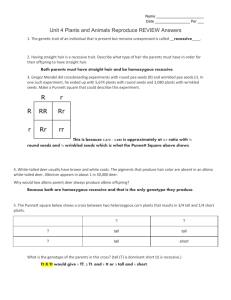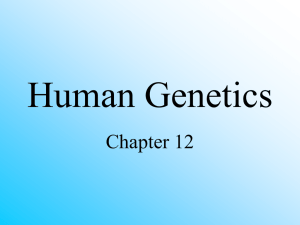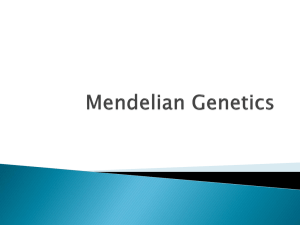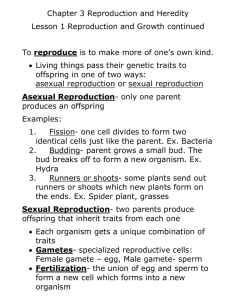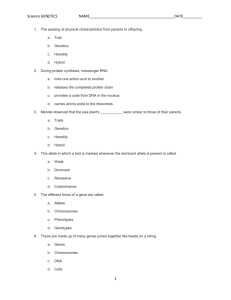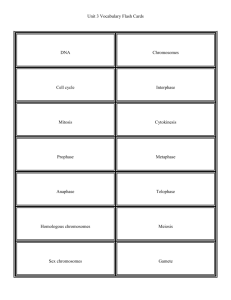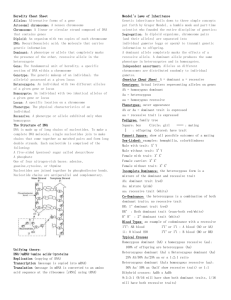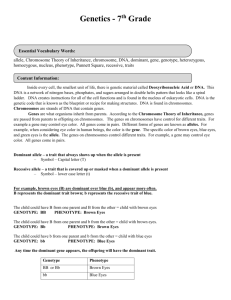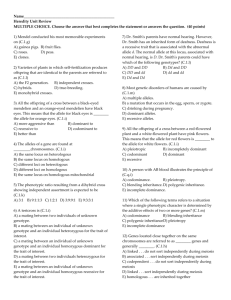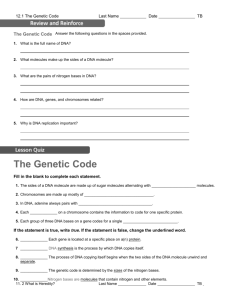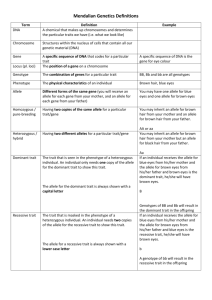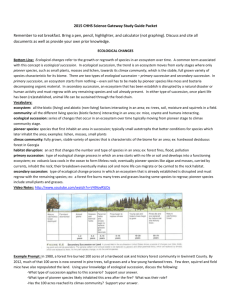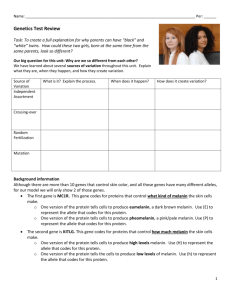click here
advertisement
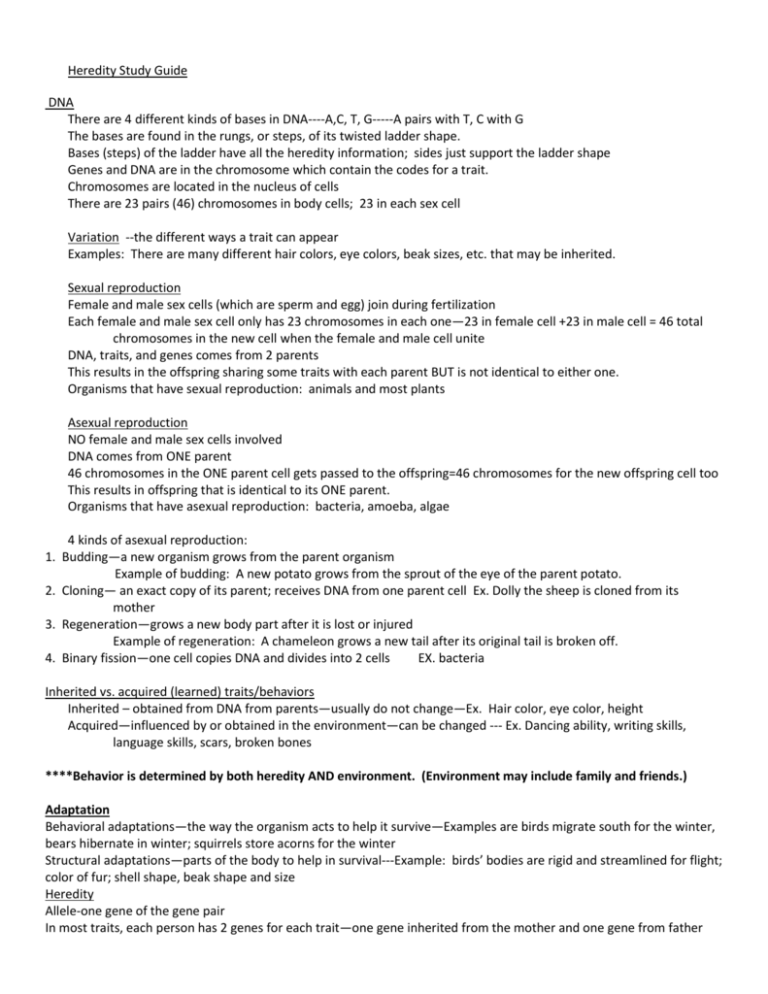
Heredity Study Guide DNA There are 4 different kinds of bases in DNA----A,C, T, G-----A pairs with T, C with G The bases are found in the rungs, or steps, of its twisted ladder shape. Bases (steps) of the ladder have all the heredity information; sides just support the ladder shape Genes and DNA are in the chromosome which contain the codes for a trait. Chromosomes are located in the nucleus of cells There are 23 pairs (46) chromosomes in body cells; 23 in each sex cell Variation --the different ways a trait can appear Examples: There are many different hair colors, eye colors, beak sizes, etc. that may be inherited. Sexual reproduction Female and male sex cells (which are sperm and egg) join during fertilization Each female and male sex cell only has 23 chromosomes in each one—23 in female cell +23 in male cell = 46 total chromosomes in the new cell when the female and male cell unite DNA, traits, and genes comes from 2 parents This results in the offspring sharing some traits with each parent BUT is not identical to either one. Organisms that have sexual reproduction: animals and most plants Asexual reproduction NO female and male sex cells involved DNA comes from ONE parent 46 chromosomes in the ONE parent cell gets passed to the offspring=46 chromosomes for the new offspring cell too This results in offspring that is identical to its ONE parent. Organisms that have asexual reproduction: bacteria, amoeba, algae 4 kinds of asexual reproduction: 1. Budding—a new organism grows from the parent organism Example of budding: A new potato grows from the sprout of the eye of the parent potato. 2. Cloning— an exact copy of its parent; receives DNA from one parent cell Ex. Dolly the sheep is cloned from its mother 3. Regeneration—grows a new body part after it is lost or injured Example of regeneration: A chameleon grows a new tail after its original tail is broken off. 4. Binary fission—one cell copies DNA and divides into 2 cells EX. bacteria Inherited vs. acquired (learned) traits/behaviors Inherited – obtained from DNA from parents—usually do not change—Ex. Hair color, eye color, height Acquired—influenced by or obtained in the environment—can be changed --- Ex. Dancing ability, writing skills, language skills, scars, broken bones ****Behavior is determined by both heredity AND environment. (Environment may include family and friends.) Adaptation Behavioral adaptations—the way the organism acts to help it survive—Examples are birds migrate south for the winter, bears hibernate in winter; squirrels store acorns for the winter Structural adaptations—parts of the body to help in survival---Example: birds’ bodies are rigid and streamlined for flight; color of fur; shell shape, beak shape and size Heredity Allele-one gene of the gene pair In most traits, each person has 2 genes for each trait—one gene inherited from the mother and one gene from father Dominant allele – one that hides or covers the other allele; always represented with a capital letter Ex. B for brown Can have 2 dominant alleles (BB) or one dominant and one recessive (Bb) combined to show the dominant trait Recessive allele – one that is hid or covered by the other allele; always represented with a lowercase letter Ex. b for white Must have BOTH recessive alleles present to show the recessive trait (bb) EX.: A rabbit has one brown-fur allele B(or gene) and one white-fur allele b (gene). The rabbit actually has brown fur, so the brown-fur allele would be the dominant allele. Natural selection Theory of “Survival of the fittest”—Charles Darwin—usually results in competition, new adaptations, and a variation of traits (such as different beak sizes, shell shapes, neck lengths) to help the organism better survive in its environment—this is a gradual, and slow process over time for new adaptations to occur in a species. On Galapagos Islands, the tortoises had different neck lengths and shell shape on the different islands as well as the finch birds having different beaks. The ones survived that had the best adaptations. Be able to answer questions about the above chart. The chart will be given on the test. Homeostasis --how the body maintains a stable internal environment Negative feedback—what the body does to restore the body back to a normal state after a change has occurred EX. – room gets too hot the body responds by sweating, exercise makes heart rate and breathing increase, etc. ------------------------------------------------------------------------------------------------------------------------------------------------------------OPEN RESPONSE Remember to use vocabulary and underline your vocabulary words. Use CSO. Practice this. 1. Be able to do a Punnett square. Identify the dominant trait and the recessive trait. Predict the chances of a child having blue or brown eyes using a Punnett square. Remember to describe in percentages or describe as ___ out of 4 chance for offspring to have brown or blue eyes. Know the allele (gene) combination (Bb, bb, or BB) that would show brown or blue eyes. Practice with the following: Traits: Blue eyes, brown eyes Mom = Bb Dad=bb, B represents brown eyes and b represents blue eyes Which trait is dominant? Which trait is recessive? ___out of 4 chances (or ____%) having blue eyes ___ out of 4 chances (or ____%) having a brown eyes ADDITIONAL MATERIAL ONLY IF COVERED: Flower reproduction Pistils are the female flower reproductive part and the stamens are the male flower reproductive part Reproduction in flowers occur when the pollen from the stamen is transferred to the female’s sticky stigma located at the top of the pistil Meiosis and Mitosis MITOSIS Body cells Yes Once 2 46 (or 23 pairs) 46 (or 23 pairs) MEIOSIS Sex cells Yes Twice 4 46 (or 23 pair) 23 Forms? DNA duplicated? Nucleus divides Number of cells formed Chromosome number of beginning cell Chromosomes in each new cell Mitosis-- process in which body cells are formed Meiosis – process in which male and female parent sex cells (sperm and egg) are formed
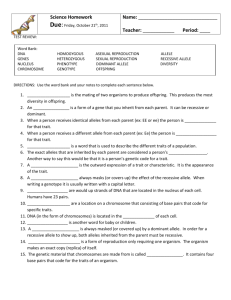
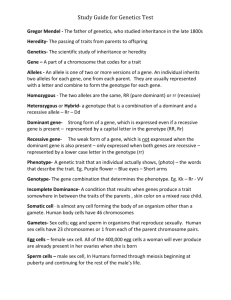

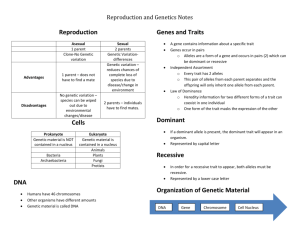
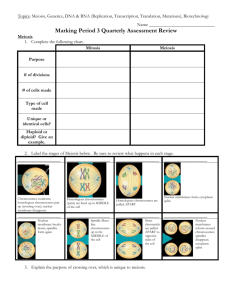

![Biology Chapter 3 Study Guide Heredity [12/10/2015]](http://s3.studylib.net/store/data/006638861_1-0d9e410b8030ad1b7ef4ddd4e479e8f1-300x300.png)
